Superb Halos
Atmospheric ice crystal optics are awesome.
With Berlin freezing over and weather services warning of ice storms and glazed frost, i thought it's a good time to talk about snow crystals and superb halos, because they are awesome.
GOOD INTERNET is a reader supported online mag. If you like what i do here, you can support this thing by upgrading your subscription to a paid plan or use one of the other support options you can find at the bottom of this issue.
My parents were avid outdoor guys, had a camper and when i was little, i was in the mountains, pretty much every weekend in the hessian Odenwald, and then some. I got my first pair of skiers at the age of 4, and even with me now having just turned 50 and haven't been skiing for at least 15 years, you could give me one of those and after a day of getting back into shape, i'd go and race down a black mogul slope without blinking an eye. Maybe even gracefully. Skiing for me is like cycling for others, i grew up in these things.
I remember that we went skiing in the austrian alps on a regular basis, and that i watched the austrian tradition of the hellish Krampusnight with demons running through the streets of Maria Alm spitting fire. I was 6 or so and had a mighty good time. Next day, i went on to learn skiing in the mountains when my parents went down the harder slopes. This went on for years, until i lost interest, got more into music and partying and only went skiing every few years or so, until i dropped it alltogether because it's also a very expensive thing to do. I miss this, dearly.
Superb Halos
Another thing i remember from those days is seeing halos. Halos are optic phenomena caused by ice crystals in the atmosphere, and when you're in the mountains, you see those a lot. However, i can't remember seeing a spectacular sight like this:
This is what the US National Weather Service La Crosse in Wisconsin calls a superb halo, and i love that combination of words, even when it surely isn't an accurate precise scientific term. Superb Halo just sounds excellent to my ears and everyone should see a superb halo at least once in their lives. I have zero doubts that halos of that spectacular kind surely must be at least part of the reason why humans tend to believe in a fictional, fantastical kingdom in the sky where winged angels roam around with, well, halos around their heads.
Here's another one, shot by Dominique Jacques-Brissette while skiing in Le Massif de Charlevoix, Kanada, in January 2021, and the accompanying video on the website of The Weather Network makes it, uhm, crystal clear that these are not in camera optical FX like the lense flares you know from Star Trek-movies, these are light effects occuring in the atmosphere, like rainbows high on acid and steroids.
Here's another ridiculously breathtaking view, shot by Michael Schneider in the Swiss Alps back in 2019, followed by an annotated version featuring all the optical FX you can see in that image:
A superb halo combines all kinds of phenomena in the atmosphere, some rarer than others. On the website Meteoros.de you can find interactive graphics for all of those atmospheric optical FX, accompanied by illustrations of the ice crystal geometry that cause those particular optics.
For instance, the relatively common 22° Halo, a ring of light around the sun, is caused by light passing through the 60° angles in hexagonal ice prisms in the atmosphere, where the light rays are bent and dispersed into an angle of usually 22°.
Historically, the first people to describe halos in a proto-scientific way were Christoph Scheiner, a jesuit priest and astronomer in Ingolstadt, who produced a diagram of the 1630 Rome halo display which was thought to be lost but rediscovered in 2011 (PDF), and Johannes Hevelius, an astronomer who observed and described the Danzig halo display on February 20, 1661, which, according to meteoros.de "is probably the most famous of all halo displays and is vividly discussed even nowadays (...) A reproduction of this drawing can be found in almost every book dealing with halos. The special thing in this display is the observation of fragments of a 90°-halo around the sun, with sundogs visible at its points of intersection with the parhelic circle."
Here's Scheiner's first drawing of the Rome halo display on the left, Hevelius' diagram of the Danzig halo to the left (the latter, unfortunately, only in low rez):


I'm a visual guy, so all those physics and mathematics fly a bit over my head and are rather uninteresting to me. But i do love fractals and mathematical visual patterns, and seeing those in winter skies around the sun leaves me stunned, and like the late George Carlin, views like these can turn you into a sun worshipper. Their history, despite understanding not much about the physics, is a fascinating read, nevertheless.
If you want more of these amazing lightshows of the sun, you can find a lot of these in the Subreddit for Atmospheric Optics, and many infos on their original Atmospheric Optics-website. Bonustrack: Here's an excellent moon rainbow, for the goths in all of us worshipping optical lightshows from light-bending ice crystal in the sky at midnight.
Which brings us to the pope of snow crystal formation.
Snow Crystals
Back in 2019, Kenneth Libbrecht, the so called "pope of snow crystals" and who, sure enough, consulted Disney when they shot Frozen, released a monograph on Snow Crystals. On a whopping 500+ pages it explains pretty much everything about how ice crystals form, "reviews our current understanding of the physical dynamics of ice crystal growth", and includes a new taxonomy of snowflakes and ice crystals, the exact things that cause those superb halos we just talked about.

That "Field Guide to Snowflakes" alone fills 60+ pages in that monograph, and features all kinds of crystals, from Simple Prisms and Stellar Plates to Split Plates and Split Stars to Crystal Twins and Twelve-Branched Snowflakes. Anything you ever wanted to know about ice crystals but never dared to ask, you can find in that book, and it's online for free on monograph on Arxiv. Even if you know snow, like me, merely from skiing and snowball fights and constructing snowmen, it's a fascinating read.
(On a sidenote: I remember when we had so much snow while staying in our camper over the weekend in hessian Odenwald in march, that we built a snow bunny for eastern. These days with climate change, these amounts of snow in march at these rather low heights on a minor mountain in germany is pretty much unthinkable.)
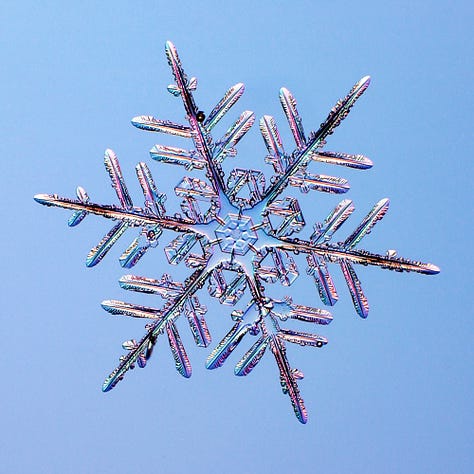
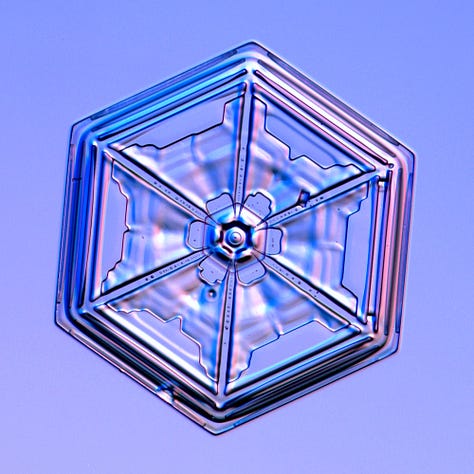
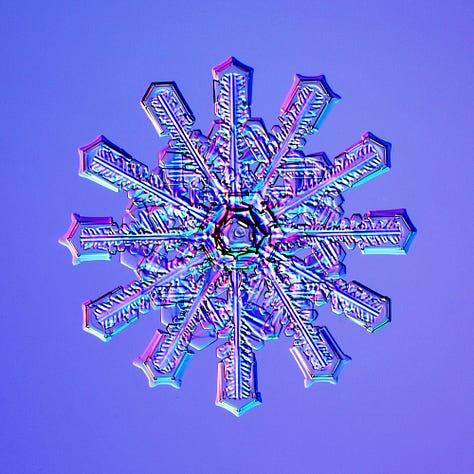


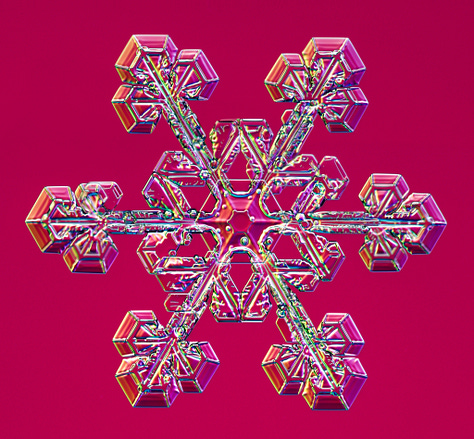
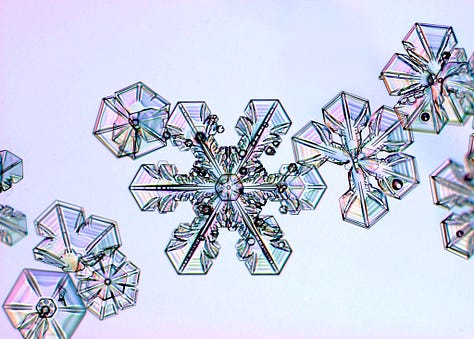
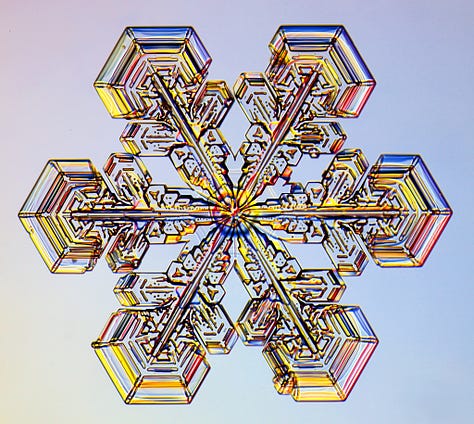
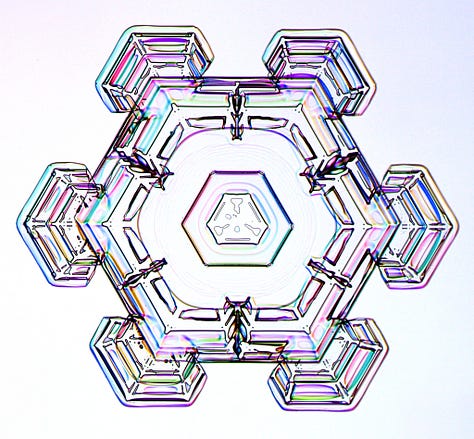
Quantamag has a good review and summary of Libbrechts work and his Grand Unified Theory of Snowflakes, and retells the history of the field of ice crystal studies going back to ancient China and, hundreds of years later, the work of Johannes Kepler in the early 17th century:
The earliest recorded musings on these delicate shapes date to 135 B.C. in China, according to Libbrecht’s research. “Flowers of plants and trees are generally five-pointed, but those of snow, which are called ying, are always six-pointed,” wrote the scholar Han Yin. But the first scientist to try to understand why this happens was probably Johannes Kepler, the German scientist and polymath.
In 1611, Kepler offered a New Year’s gift to his patron, the Holy Roman Emperor Rudolf II: an essay called “The Six-Cornered Snowflake.” Kepler writes that he noticed a snowflake on his lapel as he crossed Prague’s Charles Bridge and could not help but muse on its geometry. “There must be a cause why snow has the shape of a six-cornered starlet. It cannot be chance,” he wrote.
The pioneer of modern snowflake studies is Wilson Alwyn “Snowflake” Bentley, who developed the first techniques for snowflake photography, was the first to study them systematically and coined the phrase that "no two snowflakes are alike". You can find an extensive gallery of this first detailed snowflake photography on a dedicated website.
It's Bentleys work that Libbrechts monumental ice crystal taxonomy is building on, about which you can find much, much more on SnowCrystals.com, and three years ago, building on Libbrechts work, theoretical physicist Nathan Myhrvold (who also served as Microsofts CTO for 14 years), put together the “highest-resolution snowflake camera in the world”, capturing snowflakes “at a microscopic level never seen before”, and who equipped “his 50-pound camera system with a thermoelectric cooling system, a carbon fiber frame and LED lights, which give off less heat than standard lights”, to prevent those delicate snowflakes from melting during the shooting: “My camera’s flash is one-millionth of a second and a thousand times faster than that of a typical camera flash.”
Finally, here's a cool video summarizing Libbrechts work and now i'm waiting for the interdisciplinary scientist who fuses these advancements in ice crystal formation with the science of atmospheric halos to present a unified theory of ice crystal optics.
So, while Berlin is freezing over and the icy rain is turning streets into ice skating slopes, maybe stay home, enjoy a hot beverage and a movie, and read about the physics of weird little fractals of frozen water, making awesome lightshows in the sky.


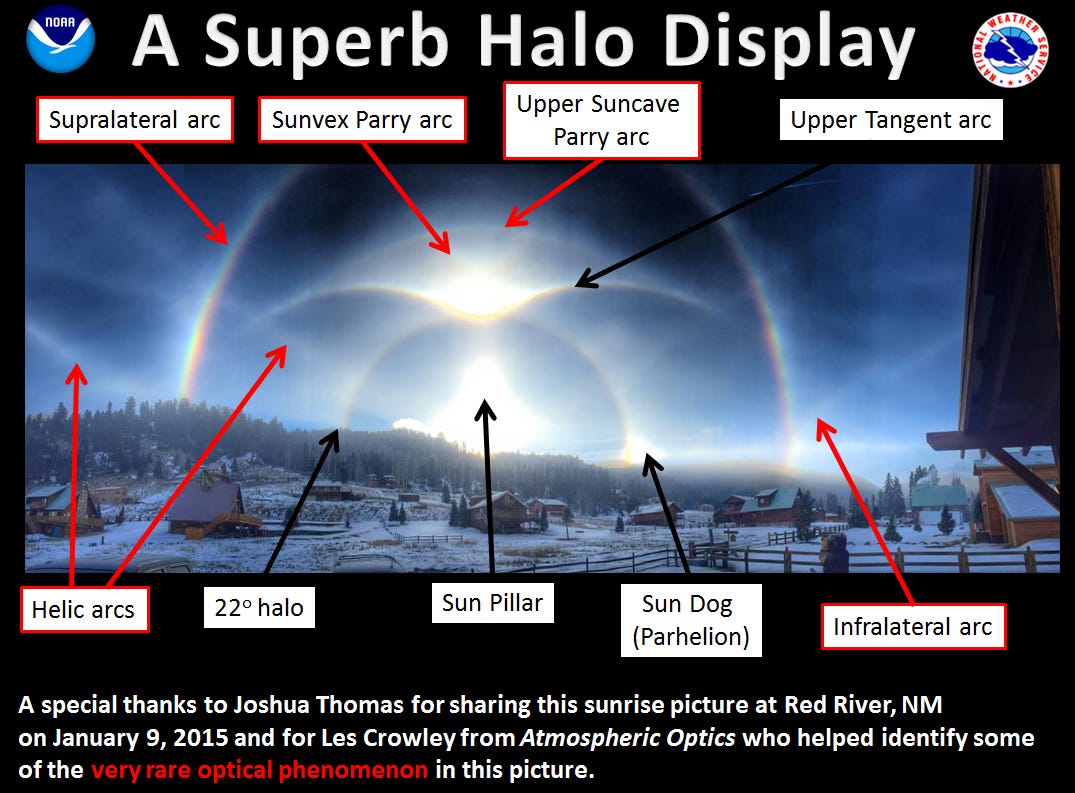



This is beautiful.
Danke!
hab gestern erst was zum Thema im Radio gehört:
https://www.swr.de/wissen/schneeflockenfaenger-vom-suedpol-100.html
Beste Grüße